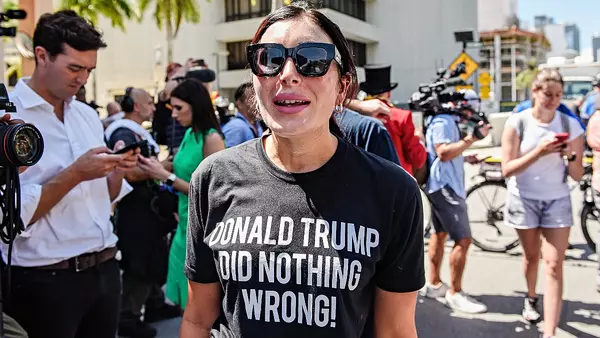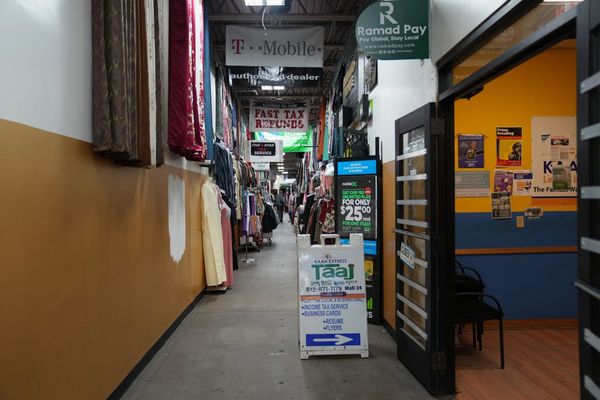
Two years ago, a white supremacist drove 200 miles to Buffalo, New York, and opened fire in a grocery store in the city’s predominantly Black East Side neighborhood, killing 10 people and injuring three.
Though the Tops Friendly Markets where the racist mass shooting took place has been remodeled, and most of the country has forgotten about the violence that occurred on 14 May 2022, Buffalo’s East Side is forever changed.
“There’s collective grieving for what was done to our community,” Julia Bottoms, a local artist, said. “I’d say there’s outrage, too, a lot of emotions: anger, outrage, frustration, sorrow. We are still processing as a community.”
A few months after the shooting, Aaron Ott, the curator of public art at the Buffalo AKG Art Museum (formerly known as the Albright–Knox Art Gallery), sought out a trio of local artists and creators to commemorate the tragedy: Bottoms, with whom Ott had previously collaborated on Buffalo’s Freedom Wall, a collection of murals of civil-rights leaders; the writer and curator Tiffany Gaines; and Buffalo’s first poet laureate, Jillian Hanesworth.
The resulting exhibition, Before and After Again, is thought to be the first of its kind, one that deals with mass gun violence and that aims to help viewers “disrupt the caustic systems that threaten our trust, faith and love for one another”, according to the exhibition’s statement.
Not wanting to be guided by their own feelings about the Buffalo tragedy, Bottoms, Gaines and Hanesworth instead spent 15 months connecting with victims’ families and others in the East Side community. Through dozens of interviews and conversations, the artists collected stories and information that shaped the exhibit, which opened earlier this year and is on view at the Buffalo AKG Art Museum through 30 September. It combines poetry, prose, paintings and other works of art, all of which aim to encourage viewers to ensure loved ones are not forgotten, while creating a space for dialogue and change.
“We wanted to know a little bit more about the lives of their loved ones. What made them laugh the hardest? What was their favorite recipe that they would make?” Bottoms said. “Just those things that create a beautiful life. Within the work, there’s the idea of memory, of what’s present and what’s lost when somebody’s taken so suddenly and so tragically.”
Bottoms said she tried to translate the family members’ interviews visually, by conveying emotions that would be relatable to audience members who may not have known the victims. She painted portraits and still lifes, Hanesworth wrote 12 poems, and Gaines wrote an essay that is on display in the exhibition space.
“Everybody can think of their loved one and what made them laugh. Everybody can think of a recipe, or a smell that brings back the memory of that person,” Bottoms said. “Something that was important for me and the families was not making somebody monumental or a symbol of something. It was so important to keep that humanity and their individual stories and essence within the portraits.”
When the artists weren’t working with families, they worked with each other, discussing what they had learned and how to move forward planning the project.
“There was a lot more responsibility because we weren’t just telling a story that was our own individual take,” Bottoms said. “We were really trying to represent this idea of communal grief. We had a huge weight to try to make sure that we did justice to what we were trying to represent.”
As the years passed after the massacre, the exhibition’s creators were keenly aware of the rest of the country moving on, while East Siders and Buffalonians were left to process their grief largely alone.
“There’s a piece in the exhibition called Salt in the Wound. It’s this sort of make-believe graph about the timeline of coverage: the idea that people are really invested when a thing happens, then it kind of dips off, and then there’s a resurgence of investment at around the one-year anniversary,” Bottoms said. “And then people just kind of forget.”
For some, forgetting is impossible.
“The title of the exhibition, Before and After Again, comes from this notion of [when] you have an event, you measure your own life and experience as happening both before and after that moment, that trauma,” Ott said. “But the ‘again’ is this episodic and epidemic kind of aspect of American life. It’s like this is bound to happen again. I don’t think we realized we were on new ground with an exhibition.”
A history of redlining
The goal of the exhibition, the artists said, is not only to address the loss and tragedy of 14 May 2022, but also to draw attention to the systemic and structural issues that allowed the shooting to happen in the first place.
Because of redlining, Buffalo is one of the most segregated cities in the country. A 2021 study found that Black Buffalonians hadn’t made economic progress in more than 31 years. The stark segregation in the city, along with underdevelopment of the East Side, structural joblessness, gentrification and limited educational opportunities were driving forces behind the inequity, the study found.
“These thinly veiled issues continue to persist in Buffalo,” Gaines said. “And I think that was the intention of all of us involved, to not just sit in the grief of the loss of the day, but to really challenge viewers to speak about some of these ongoing issues that we still see in our community.”
During the research for the exhibition, the group connected with Doug Ruffin, a filmmaker and historian from Buffalo, whose film Figmos PTL (“Finally, I Got My Own Supermarket, Praise the Lord”) tells the story of a Black-owned-grocery store that opened on Jefferson Avenue on the East Side in the 1980s. Following Figmos’s closure in 1983, the East Side was without a grocery store until Tops Friendly Markets opened on the same street in 2003.
“There’s a generational gap between that knowledge. If you were born before 1975, you might know Figmos, but if you’re born after that date, it just didn’t exist on your radar,” Ott said. “Jefferson was known as Black Main Street. There’s a lot of businesses that are lost, so there’s a lot of history that’s lost.”
Hanesworth said she doesn’t know what it looks like to see her community thrive.
“When you look at the social and economic makeup of the East Side of Buffalo, it’s one that not only makes it really hard to thrive economically, but it’s almost like it was designed in a way that almost convinced us that our role is just to survive,” Hanesworth said. “There are no new issues. There were no new issues after May 14, it was just exacerbated issues.”
As a poet, Hanesworth knew words were the most accessible way to give voice not only to her own thoughts about survival, but to those of her community members.
“There’s one poem called We Been Cold where it’s like: ‘We been hungry.’ There’s one stanza that’s like: ‘We been yelling. Momma said, ‘Black people always so loud.’ We just trying to be seen, be heard. We just want them to know that we hungry. That we cold. We been yelling.’”
‘The love that is here’
Buffalo has a robust arts community and cultural landscape. There are few parts of the city unadorned with murals, installations or uniquely designed buildings and homes. The arts community turned out immediately after 14 May to help process and begin the long journey of healing from the shooting.
“It feels almost natural that individuals and communities would look to the arts to navigate and sort of process that experience that we went through,” Gaines said.
The summer following the shooting, the Burchfield Penney Art Center, where Gaines works as a curator, and the Buffalo Urban League, collaborated to host an arts healing event on Jefferson Avenue. Other community groups and individuals have hosted similar events near the Tops market aimed at processing grief and tragedy through art.
Last month, Hanesworth hosted an open-mic night at the Buffalo AKG Art Museum, during which writers, poets and other literary artists were able to share their work with their community in a space that was once considered not for them. In addition to the panel discussion the exhibition’s creators have already had, they’re planning future panel discussions, all of which aim to continue the dialogue around the tragedy, while also encouraging participants to work for change.
“It’s been an honor to be able to be part of this exhibition and to shine a light on this community and the strength and the love that is here,” Gaines said. “But also to continue to support conversation around how we address white supremacist violence and racial inequity, so that we make changes so that this doesn’t happen again.”







